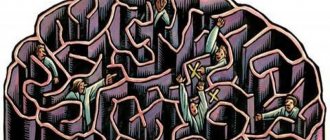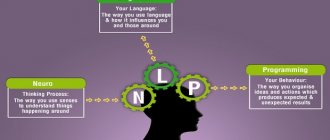Great minds have been studying the human psyche for decades, but many questions still have no answers. What is hidden in the depths of a human being? Why do events that happened once in childhood still affect people to this day? What makes us make the same mistakes and hold on to hateful relationships with a death grip? Where do dreams originate, and what information is contained in them? These and many other questions regarding the mental reality of man can be answered by the revolutionary psychoanalysis, which has corrected many of the fundamentals of psychology, created by the outstanding Austrian scientist, neurologist and psychiatrist Sigmund Freud.
Basic concepts of psychoanalysis
Here are a few fundamental ideas of psychoanalysis, to one degree or another, inherent in most psychoanalytic methods.
— A person’s behavior, the state of his psyche (consciousness) largely depend on internal unconscious motives, which are determined by LIBIDO or sexual desire (in the process of development, this position was repeatedly corrected or challenged by Freud’s followers).
— The main cause of psychological problems of the individual (neurotic behavior, depression, anxiety, complexes) is the inevitable conflict between unconscious impulses (desires) and the conscious part of the personality.
— A significant weakening of this conflict can be achieved through the individual’s awareness of the traumatic memories that cause the conflict, by releasing this material from the sphere of the unconscious and subsequent work with it through a psychoanalyst (living, analyzing, accepting the traumatic material).
— The human psyche has protective mechanisms that prevent awareness of the contents of the unconscious (main article — Psychological defenses of the individual).
Brief summary
Psychoanalysis by Sigmund Freud is the greatest attempt to come to an understanding and description of those components of human mental life that were incomprehensible before Freud. The very term “psychoanalysis” is currently used to describe:
- Scientific discipline
- A set of measures to study mental processes
- Methods for treating neurotic disorders
Freud's work and his psychoanalysis are often criticized even today, but the concepts that he introduced (Id, Ego, Super-Ego, defense mechanisms, sublimation, libido) are understood and applied in our time by both scientists and simply educated people. Psychoanalysis is reflected in many sciences (sociology, pedagogy, ethnography, anthropology and others), as well as in art, literature and even cinema.
We also recommend reading:
- Storytelling
- Free association method
- Fear: psychological foundations and famous scientific studies of this phenomenon
- Why does a person need a relationship: answers from psychologists
- What is consciousness?
- Ideas of Carl Gustav Jung
- Myths about hypnosis
- Halperin's theory of mental action
- Symboldrama as a way to reach the unconscious
- Cognitive psychology and cognitive psychotherapy
- Skinner's operant conditioning as a technology for personality formation
Key words:1Communication
The structure of personality (psyche) according to Freud
According to Sigmund Freud's theory, there are three different levels of human consciousness.
1. CONSCIOUSNESS . This is the part of our consciousness that we are aware of at every moment of time. Here our thoughts, ideas, concepts are located, the emotions that accompany the thought process are felt and realized, here, through thoughts and sensations, the rational experience of knowing the world is integrated (perception of information using the senses). Consciousness is the only part of our psyche (and according to Freud, a very insignificant one) that is subject to real awareness and evaluation.
2. PRECONSCIOUS (subconscious). In computer terms, this part of the psyche is a kind of RAM. We are not aware of this part at every moment of time (and it would be irrational), however, if necessary, we always have access to its contents. This contains our memories, our knowledge, in general, this is our memory.
3. UNCONSCIOUS . This is a part of our psyche that is inaccessible to detection and rational awareness. Here is material that, for one reason or another, has been repressed from consciousness and preconsciousness. These are fears, unacceptable aspirations (sexual and aggressive), repressed experiences (most often traumatic), irrational aspirations.
In general, CONSCIOUSNESS, PRECONSCIOUSNESS and the UNCONSCIOUS is a kind of virtual information environment, which, although it is an integral part of our personality, is accessible to it to varying degrees.
The personality itself, which includes all three levels of consciousness (psyche), structurally consists of the following parts - ID (It), Ego (I) and Super Ego (Super Ego) .
— ID (IT) is the original (basic) part of the psyche with which every human being is born, it is an innate, and not acquired as a result of development, part of the personality. It is what is responsible for survival in the real world, responsible for providing our basic needs, through emotional impulses making us WANT to realize these needs.
According to Freud, ID is guided by the principle of maximum pleasure (enjoyment), and by its nature carries the principle of Absolute Egoism and need satisfaction. Metaphorically, for the ID, the only real good is the satisfaction of needs, immediately and at any cost. So an infant, whose personality structure has not yet been formed, is guided by precisely this principle.
In Freudian psychoanalysis, this part of the psyche is believed to reside entirely in the unconscious.
- EGO (I). Freud believed that this part of the personality develops in the first three years of an infant's life. The reason for development is the need to interact with the outside world; the EGO develops, guided by the rational principle of reality. What does this mean? This means that the child begins to understand that immediate and unconditional satisfaction of ID desires is associated with certain difficulties, and their fulfillment must be linked to certain realities of the surrounding world. These realities are the presence of other people, each of whom also has their own desires and needs. Based on experience, there is an awareness that unconditional selfish behavior (what ID requires) can bring certain problems and delay in getting what you want. This is how behavior strategies are gradually formed, taking into account external circumstances. From the point of view of Freud's theory, this part of the psyche is located in consciousness, in the preconscious, and in the unconscious.
- SUPER EGO . According to Freud, this part of consciousness is formed around the age of 5 and contains moral principles (ethics), which are formed in the consciousness due to the influence of parents, other people, as well as the previously described natural external circumstances of the child’s life. It is this part of the personality that is responsible for the formation of assessments of bad - good, acceptable - unacceptable, and subsequently, for the formation of basic ideas about what the world around us is like and what place the person himself occupies in it. Freud divided this part of the personality into two parts - CONSCIENCE and I - IDEAL . SUPER EGO, like EGO, is located in all three “elements”, in consciousness, in preconscious and in the unconscious.
According to Freud, an indicator of a psychologically healthy personality is the effective control of the EGO over the Super Ego and Id. Taking this position, we can conclude that the Ego must be “stronger” than other parts of the personality. In fact, based on the logic of the personality structure, the role of the Ego comes down to rational activity to achieve a compromise between the Id and the Super Ego. However, it should be understood that the role of the Self, in any case, comes down to satisfying the ID as quickly as possible and, at the same time, in the safest possible way for the individual. Finding an ideal compromise between ID and SUPER EGO in real life circumstances in society is almost impossible. Considering this thesis, we can conclude that it is impossible to completely eliminate psychological stress in the human psyche.
If the Super Ego is dominant in a person, then we end up with a Puritan who strictly follows moral principles and (or) high ideas that are at the forefront and the suppressed aspirations of the Id, constantly striving to come out. If the Id is dominant, then this person will constantly strive for pleasure, regardless of other people and social attitudes. The ideal expression of such a situation would be a psychopathic personality with dissocial personality disorder.
Continuation, the next part of the topic is PSYCHOANALYSIS AS A METHOD OF PSYCHOTHERAPY.
Major discoveries
Freud made several fundamental discoveries in the field of psychology, introducing new trends and concepts. These include:
- Unconscious. By the Unconscious, Freud understood a special area of the psyche, the presence of which a person is not aware of. The unconscious seeks to subjugate the will and relieve the human individual from the pressure of moral standards.
- Libido. Freud called it the engine of the individual's mental life. Libido activity affects ambitions and aspirations. Freud draws a parallel between sexual and social activity: a man’s libido is stronger than a woman’s, so he has a stronger need for sex and a desire for competition.
- Interpretation of dreams. The unconscious constantly tries to overpower the will of the individual and sends him signals reminding him of suppressed desires. A person receives these signals in the form of dreams. To get rid of anxiety, you need to analyze dreams and find the true causes of discomfort.
- Neuroticism. Freud grouped mental disorders caused by suppression of impulses into one group and called them nervous diseases or neuroticism. All people existing within European culture are susceptible to neuroticism, since they are distant from nature and are forced to constantly control their natural needs.
Not all contemporaries welcomed Freud's ideas; some criticized them. Karen Horney, an American psychoanalyst, in one of her works examined in detail Freud's theory of women's envy of the male penis and suggested that in fact a man is jealous of the presence of a uterus and the ability to reproduce, and the driving force of the human personality is not libido, but anxiety. Karen's bold views made her one of the iconic figures of neo-Freudianism.
Methods of psychological protection
Crowding out . Suppression, exclusion from consciousness of unpleasant or unacceptable impulses. In this case, they are transferred to the unconscious. Substitution .
Reorientation of impulse from one object to another, more accessible one. Rationalization . An attempt to rationally justify desires and actions caused by such a reason, the recognition of which would threaten the loss of self-esteem. Projection .
Unconscious transfer of one's own feelings and attractions to another person. Somatization . Fixation on the state of one's health as a form of protection from conflicts. Reactive education . Replacing unacceptable tendencies with the exact opposite. Regression . Return to primitive forms of behavior in a difficult situation. Denial . Unfulfilled desires, thoughts, and impulses are not recognized.
Their very existence is denied. Sublimation . Transformation of socially unacceptable impulses into socially acceptable and encouraged ones. The clearest example is the sphere of art.
THEORY OF A. MASLOW
Maslow Abraham Harald (1908-1970) - American psychologist. The founder of humanistic psychology, which studies the problem of the value of man himself. Created a hierarchical model of motivation (“Motivation and Personality”, 1954).
Maslow is the author of a detailed classification of motives, the features of which are as follows:
- represents not individual, but groups of motives
— groups of motives are ordered in an integral hierarchy.
Orderliness depends on the level of development of the individual, on age and the role of the social motivating group in the development of the individual.
Needs, or groups of needs, act as the initiator of activity.
Activity is not determined from within, it is attracted from outside by the opportunity to satisfy a need.
The needs that form the hierarchy interact with each other as follows:
— until the needs of lower levels are satisfied, the needs of a higher level are not updated;
- if the subject’s needs of different levels are actualized, then the needs of the life level win in this conflict.
Hierarchy of needs (according to A. Maslow):
Level I: physiological needs (hunger, thirst, etc.);
Level II: need for safety;
Level III: the need for social connections (appearance, love, identification, affiliation, etc.);
Level IV: need for self-esteem (signs, achievements, approval, etc.);
Level V: the need for self-actualization (realization of one’s own abilities, understanding and comprehension of oneself and others).
Self-actualizing individuals make up only 1% of the total number of people.
This need is not always achieved; this is the ideal to which a person strives (or should strive).
Oedipus complex and Electra complex
Freud's concept of philosophy includes a deep analysis of human sexual desires. The scientist believed that they are formed in childhood and manifest themselves as the Oedipus Complex or the Electra Complex.
The description of the complexes was based on Freud’s observations of child-parent relationships and ways of showing affection in boys and girls. He found that boys pay much more attention to their mother, strive to hug or kiss her, and require constant attention. If a mother prefers to spend more time with her husband rather than with her son, the boy becomes jealous. Unconsciously, he experiences sexual cravings for his mother and perceives his father as a rival. Girls demonstrate attachment to their father and show a negative reaction to his attitude towards their mother.











